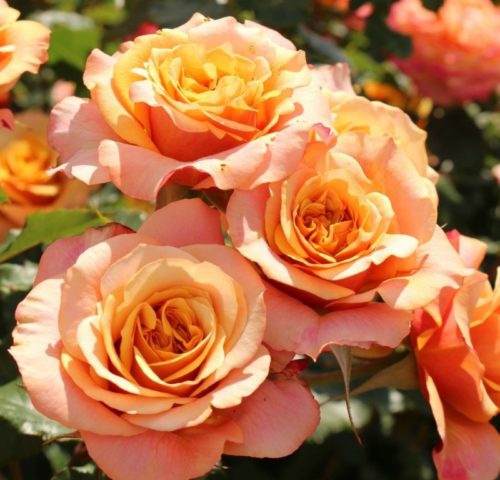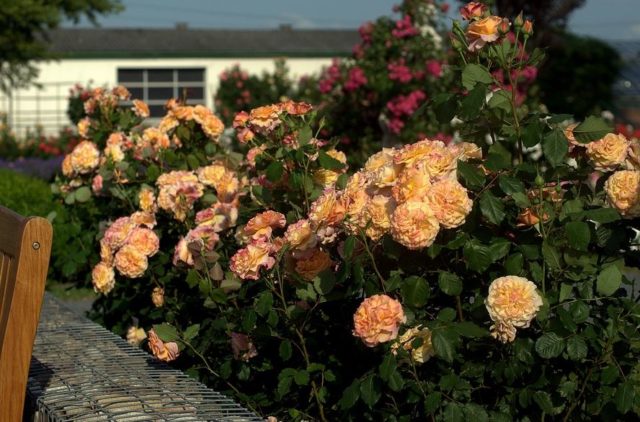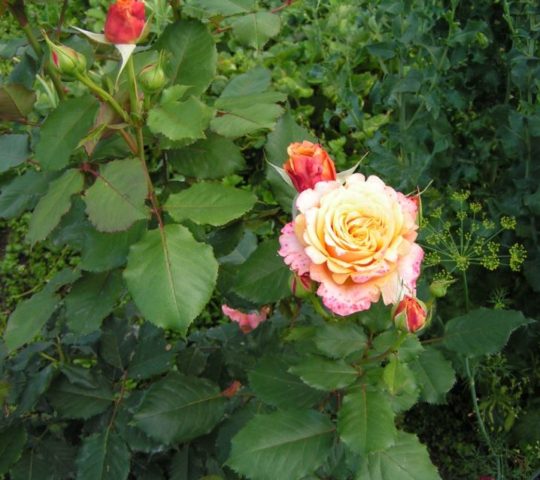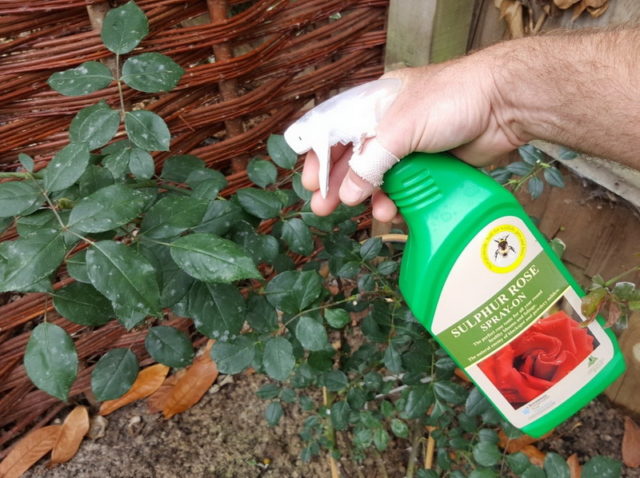Content
Rosa La Villa Cotta is an ornamental plant with a unique color. This is a new hybrid variety that has gained popularity among domestic gardeners. The flower has not only amazing decorative qualities, but also many other positive characteristics. Therefore, it is recommended that you familiarize yourself with the description of the plant and the features of growing in the open field.
Breeding history
La Villa Cotta variety was bred in 2013 in Germany. The breeder is Wilhelm Cordes III, who is the grandson of the famous German gardener and breeder who founded the Wilhelm Cordes & Sons company. The company specializes in growing and breeding new roses.
La Villa Cotta is a cross between several species. In breeding works, the varieties Angela, Harlekin, Belvedere were used.
Description of La Villa Cotta rose and characteristics
It is a shrub shrub plant. The average height is 110 cm. Under favorable conditions it grows up to 130 cm. A bush with erect stems, medium spreading.
Shoots are strong, with few thorns. The bark is dark green, without fibers. The bush contains up to 20 stems. Shoots are prone to lignification.
Adult specimens can be deformed due to the overgrowth of the stems. Therefore, periodic pruning of the bushes is needed. A garter or the use of supports is required, provided that the bush grows above 120 cm and can break under the weight of the flowers.
The variety is characterized by a high growth rate. Annual growth reaches 30 cm. The buds are tied on both new and last year's shoots.
The foliage is abundant and dense. The color is dark green. The leaves are ovoid with jagged edges. The length of the plates reaches 7-8 cm, they are distinguished by noticeable light veins.

Flowering begins in June and lasts until the end of summer.
The budding period takes place in May. In the future, the plant is covered with large double flowers. The color is copper-yellow with creamy pink and peach shades on the back. The shape of the flowers is cup-shaped, and the diameter reaches 10 cm. Each one consists of 70-80 petals.
The bushes exude a light, subtle aroma. In the spring-summer season, it attracts pollinating insects, which promote more abundant flowering.
Like other roses, Cordessa La Villa Cotta is frost-resistant. This variety can withstand temperatures from -17 to -23 degrees. Belongs to the 6th group of frost resistance. For the winter, it is advised to cover the rose in order to eliminate the risk of freezing.
La Villa Cotta is a drought-resistant variety. The plant withstands well a short-term lack of moisture without loss of decorative qualities. Prolonged drought leads to a reduction in the duration of flowering and subsequent wilting.
The rose is characterized by an average sensitivity to precipitation. Prolonged rains can negatively affect the condition of the plant.
The flower is known for its resistance to infections. La Villa Cotta is not susceptible to powdery mildew, black spot and rust.
Advantages and disadvantages of the variety
La Villa Cotta is in many ways superior to other hybrid varieties. The plant has many benefits that every gardener will appreciate.
Among them:
- long flowering;
- beautiful color of buds;
- unpretentious care;
- high resistance to frost;
- drought resistance;
- low sensitivity to infections and pests.
There are practically no disadvantages of such a plant. The disadvantages include the need for regular pruning and formation of a bush. Also, the disadvantage is the exactingness of lighting and acidity of the soil, as this can affect the decorative qualities.
Reproduction methods
To preserve varietal traits, only vegetative methods are allowed. La Villa Cotta roses are not grown from seeds.
Breeding methods:
- dividing the bush;
- cuttings;
- reproduction by layering.
Such methods are considered to be the most effective. The procedure is recommended to be carried out in the spring, before budding begins. New specimens can be grown in the fall, after flowering.
Growing and care
In the description of the rose La Villa Cotta with a photo, it is said that the plant does not tolerate shade. Therefore, such a flower requires an area well lit by the sun. Can be planted in partial shade, provided that the plant receives a sufficient amount of ultraviolet radiation during the day.
The La Villa Cotta variety needs good aeration. Therefore, it is planted in places with full air circulation. It is advisable that the site is not in a lowland where flooding by groundwater is possible.

Optimal acidity for rose growth - 6.0-6.5 pH
Chernozem and loamy soil are best suited for growing roses. It needs to be enriched with organic fertilizers 2-3 months before planting. Usually, the bushes are transferred to open ground in the fall, so compost or manure can be applied in early summer.
Planting is carried out in dry weather, preferably in the evening. The site is cleared of weeds in advance.
Subsequent stages:
- Dig a hole 60-70 cm deep.
- Place drainage material (crushed stone, pebbles, gravel) on the bottom with a layer of at least 10 cm.
- Fill up the soil mixed with compost or rotted manure.
- Dip the roots of the seedling in a clay mash for a few minutes.
- Place the roots of the seedling on the enriched layer with a depth of 5-6 cm.
- Cover with loose soil and compact the soil around the surface shoot.
- Pour warm water over the seedling under the root.

Saplings begin to bloom 2 years after planting
Rose bushes need abundant watering, especially in summer. For each bush, 15-20 liters of settled water are used. It should not be cold so that the roots do not suffer from hypothermia. Watering is carried out 1-2 times a week as the soil dries up.
The soil around the plant must be loosened. Otherwise, it becomes denser and prevents proper nutrition of the roots. The procedure is carried out once every 2-3 weeks. To retain moisture in dry weather, add a layer of mulch.
In spring and autumn, the La Villa Cotta rose bush must be pruned. Overgrown, wilted or dry shoots are removed by 2-3 buds. In summer, cut the closing buds from the rose to speed up the formation of new ones.
Roses of La Villa Cotta respond well to organic and mineral fertilizers. Top dressing is carried out before and after flowering, as well as in the fall in preparation for winter.
You need to cover the bushes in early November or later if there are no strong frosts. At the bottom, the rose is spud to prevent freezing of the roots. The upper shoots are covered with non-woven breathable material.
Pests and diseases
Numerous reviews of La Villa Cotta roses indicate that the variety is resistant to infections. The cultivar is insensitive to powdery mildew, mottling and rust. It is recommended to spray the plant with a fungicide once. Alternatively, use soapy water, calendula or nettle infusion. Irrigation is carried out in the spring after sanitary pruning.
Roses of La Villa Cotta can be affected by pests, including:
- bear;
- rose aphid;
- leaf rollers;
- spider mite;
- cicadas;
- scabbards;
- slobbering pennies.

Pest control involves the use of insecticidal preparations
Affected shoots from bushes should be removed to reduce the risk of infection of healthy ones. For prevention, it is recommended to deeply loosen the soil near the bushes so that the larvae of the pests freeze.
Application in landscape design
La Villa Cotta roses are the perfect garden decoration. The plant looks good anywhere on the site. The flower is suitable for monochrome and multi-tone compositions. It is used for both single and group planting.
Sprawling bushes are often planted to decorate curbs, garden buildings, artificial reservoirs. Designers advise placing roses near verandas and loggias so that they can be clearly seen from the windows.
The flower is not too picky about the composition of the soil. Therefore, it can be planted next to almost any ornamental plants.
Roses are best combined with astilbe, gladioli, phlox and geyher. Less commonly combined with decorative varieties of rose hips and magnolias.
Near La Villa Cota, it is advised to plant low-growing perennials with early flowering. They will help decorate the site until the rose blooms.
Conclusion
Rosa La Villa Cotta is a popular hybrid variety that is resistant to frost and fungal diseases. The plant has a unique color, so it is actively used for decorative purposes. The flower is unpretentious to care for and not too picky about the conditions. Therefore, it can be grown in almost all regions, including those with harsh climates.
Reviews for the park rose La Villa Cotta








